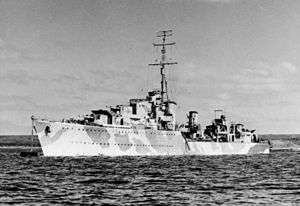Convoy PQ 8
Convoy PQ 8 was an Arctic convoy sent from Great Britain by the Western Allies to aid the Soviet Union during World War II. It sailed in January 1942 and arrived in Murmansk with the loss of one escort sunk, and one ship damaged.

Ships
PQ 8 consisted of eight merchant ships; five British, one Soviet, one American, one of Panamanian registry. The convoy was escorted by two minesweepers, joined by an ocean escort of two destroyers Matabele and Somali, supported by the cruiser Trinidad. The convoy was joined in the last stage of the voyage by two Royal Navy minesweepers based at Murmansk.
Voyage
PQ 8 sailed from Hvalfjord on 8 January 1942. and was joined on 10 January by the Ocean escort. The German navy (Kriegsmarine) had established a patrol line of four U-boats from Kirkenes to search for the convoy, but it was undetected by German aircraft or U-boats in the continuous darkness of the polar night, until the last day of the voyage.
On 16 January the Eastern Local Escort joined. On 17 January the convoy was found by U-454 under the command of Kapitänleutnant Burkhard Hackländer, one day short of their destination.[1] The first ship sunk was the Russian trawler RT-68 Enisej at 6.32 am.[1] That evening the merchant ship Harmatis was hit at 6.46pm by a single torpedo and taken in tow by the minesweeper Speedwell, with HMS Matabele providing escort as the rest of the convoy continued on ahead. U-454 was able to manoeuvre into a suitable position and at 10.21 pm fired and hit the Matabele in the stern area with a single torpedo which detonated a magazine, causing the destroyer to sink in less than two minutes.[1] Out of her complement of 238 only two survived of the four that were rescued up by the minesweeper Harrier.[1] The Harmatiswas successfully towed to Kola. All other ships of PQ 8 arrived safely. HMS Sharpshooter arrived on the scene and launched several unsuccessful counter attacks against the submarine which eventually escaped.[2]
The German navy planned to attack the convoy with the battleship Tirpitz, but shortages of fuel and insufficient destroyer escorts forced a postponement of the attack.[3]
List of ships[4]
| Name | Flag | Tonnage (GRT) | Notes |
|---|---|---|---|
| British Pride (1931) | 7,106 | ||
| British Workman (1922) | 6,994 | ||
| Dartford (1930) | 4,093 | ||
| El Almirante (1917) | 5,248 | ||
| Harmatris (1932) | 5,395 | Torpedoed, towed in by HMS Speedwell | |
| HMS Harrier | Escort 8 January - 17 January | ||
| HMS Hazard | Escort 16 January - 17 January | ||
| Larranga (1917) | 3,804 | ||
| HMS Matabele | Escort 11 January - 17 January | ||
| HMS Sharpshooter | Escort 16 January - 17 January | ||
| HMS Somali | Escort 11 January - 17 January | ||
| Southgate (1926) | 4,862 | ||
| HMS Speedwell | Escort 8 January - 17 January | ||
| Stary Bolshevik | 3,974 | ||
| HMS Trinidad | Escort 11 January - 17 January | ||
Notes
- Paterson. p. 59
- "HMS Sharpshooter 1942". Halcyon Class Ships. 17 January 2012. Retrieved 24 September 2018.
- Garzke & Dulin, p. 250
- "Convoy PQ.8". Arnold Hague Convoy Database. Retrieved 15 October 2013.
References
- Blair, Clay (1996). Hitler's U-Boat War Vol I. New York: Random House. ISBN 0-304-35260-8.
- Garzke, William H.; Dulin, Robert O. (1985). Battleships: Axis and Neutral Battleships in World War II. Annapolis, MD: Naval Institute Press. ISBN 978-0-87021-101-0.
- Kemp, Paul (2000). Convoy! Drama in Arctic Waters. London: Cassell. ISBN 978-0-30435-451-1.
- Paterson, Lawrence (2016). Steel and Ice: The U-Boat Battle in the Arctic and Black Sea 1941-45. Stroud, Gloucestershire: The History Press. ISBN 978-1-59114-258-4.
- Schofield, Bernard (1964). The Russian Convoys. London: BT Batsford.